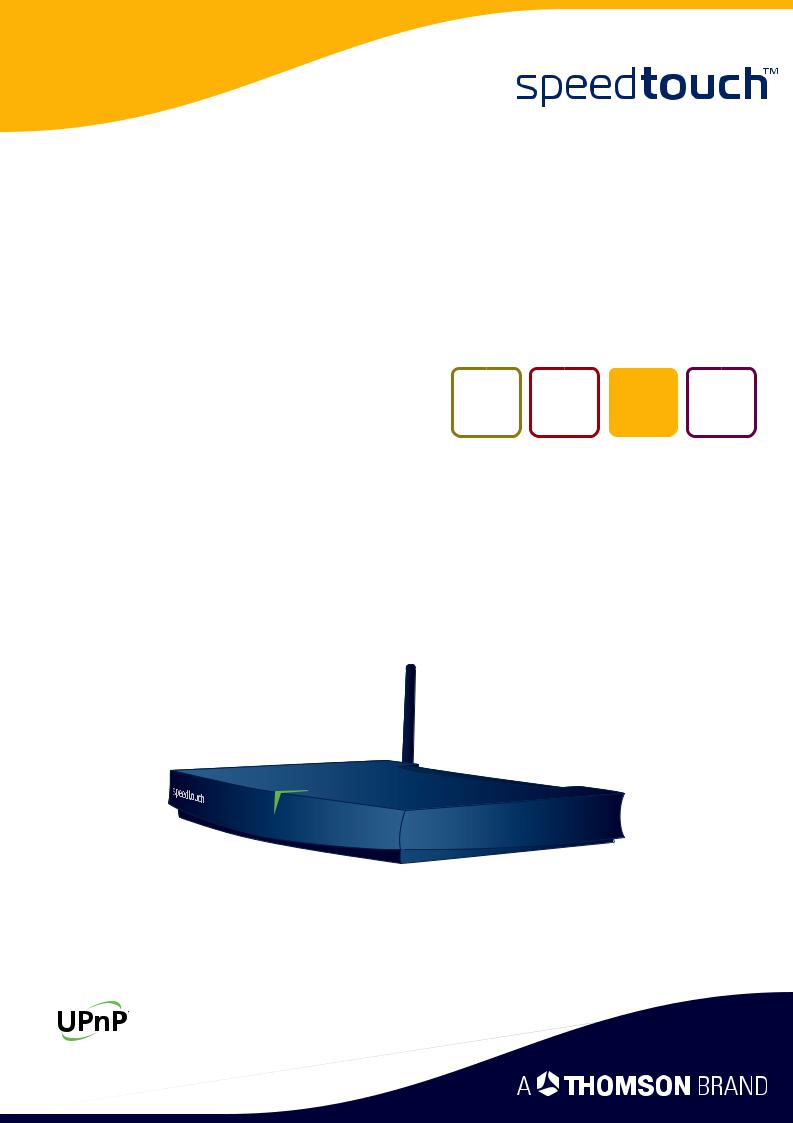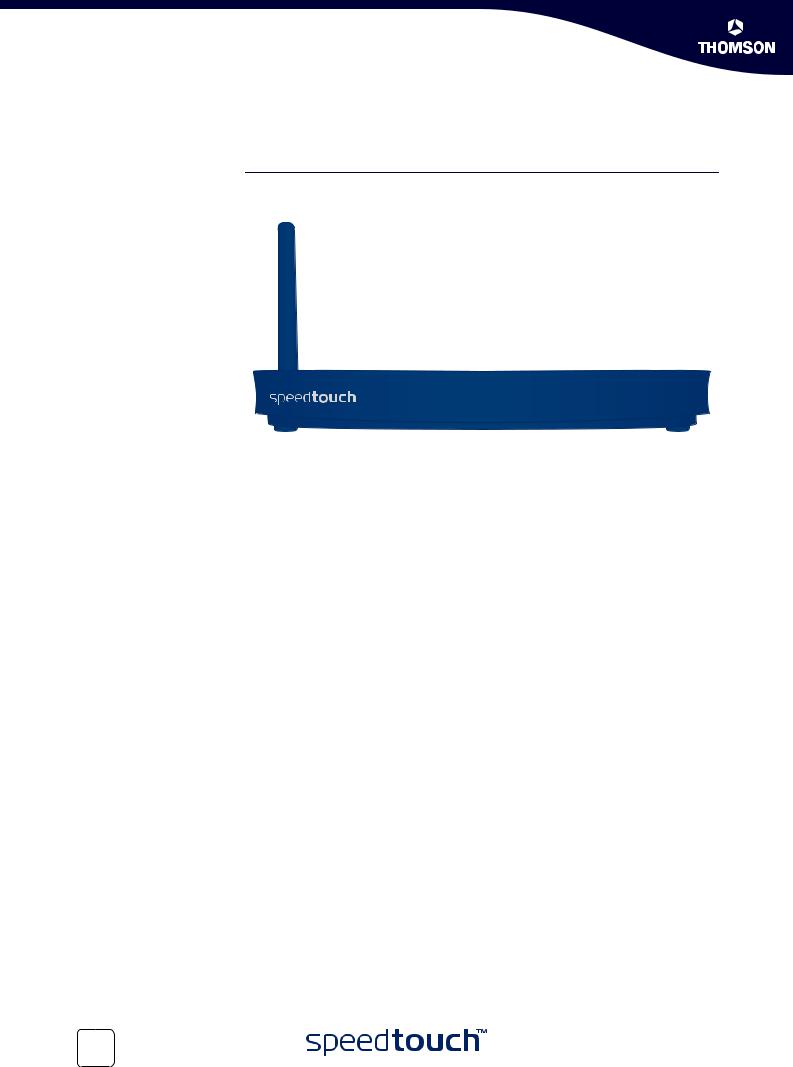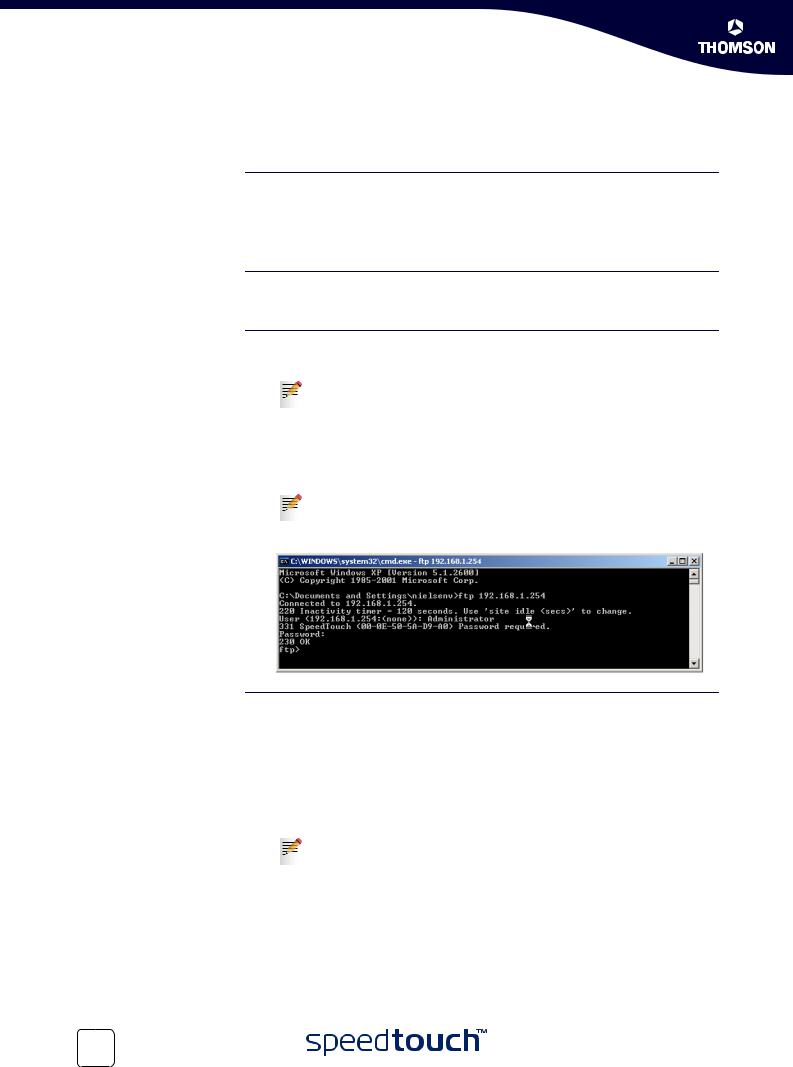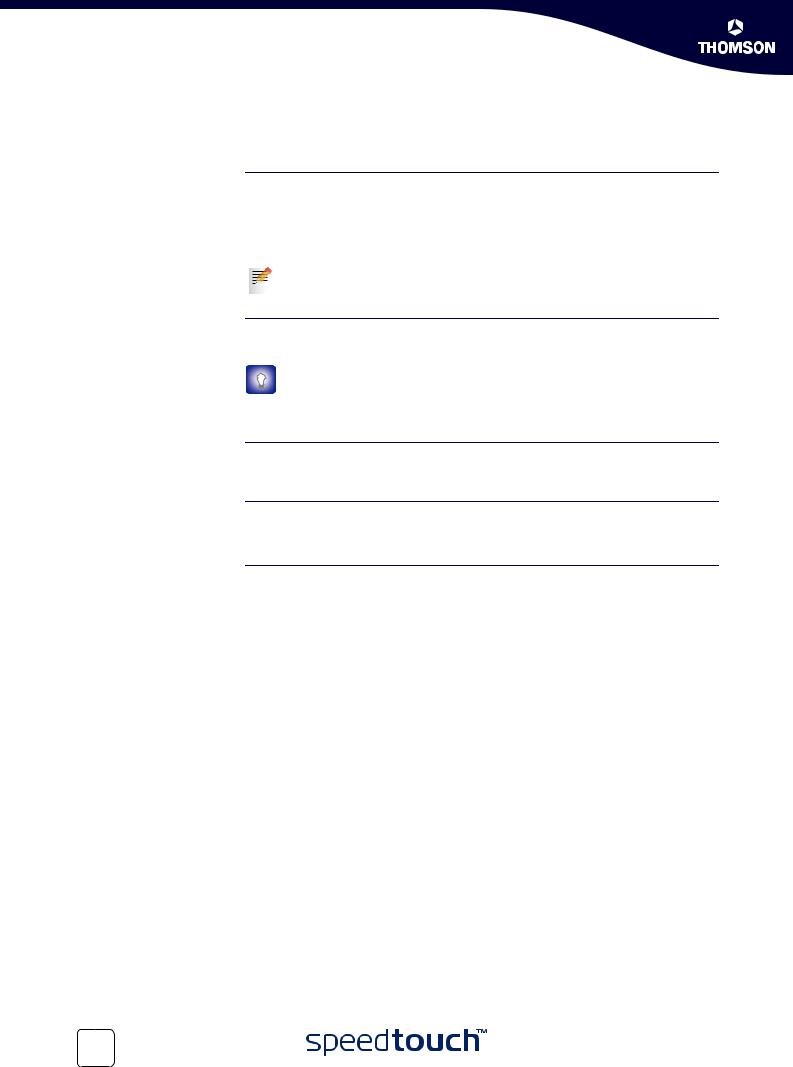RCA 620, 608WL, 608, 605 User Manual

SpeedTouch™
605/608/608 WL/620
(Wireless) Business DSL Routers
User’s Guide
Power
Ethernet
|
LA |
N |
W |
|
|
|
|
|
in |
Plug |
- |
|
ISD |
N |
|
Internet

SpeedTouch™
605/608
608 WL/620
User’s Guide

Copyright
Copyright ©1999-2005 THOMSON. All rights reserved.
Distribution and copying of this document, use and communication of its contents is not permitted without written authorization from THOMSON. The content of this document is furnished for informational use only, may be subject to change without notice, and should not be construed as a commitment by THOMSON. THOMSON assumes no responsibility or liability for any errors or inaccuracies that may appear in this document.
Thomson Telecom Belgium
Prins Boudewijnlaan, 47
B-2650 Edegem
Belgium
www.speedtouch.com
Trademarks
The following trademarks are used in this document:
SpeedTouch™ is a trademark of THOMSON.
Bluetooth® word mark and logos are owned by the Bluetooth SIG, Inc.
Ethernet™ is a trademark of Xerox Corporation.
Wi-Fi® and the Wi-Fi logo are registered trademarks of the Wi-Fi Alliance. "Wi-Fi CERTIFIED", "Wi-Fi ZONE", "Wi-Fi Alliance", their respective logos and "Wi-Fi Protected Access" are trademarks of the Wi-Fi Alliance.
UPnP™ is a certification mark of the UPnP™ Implementers Corporation.
Microsoft®, MS-DOS®, Windows® and Windows NT® are either registered trademarks or trademarks of Microsoft Corporation in the United States and/or other countries.
Apple® and Mac OS® are registered trademarks of Apple Computer, Incorporated, registered in the United States and other countries.
UNIX® is a registered trademark of UNIX System Laboratories, Incorporated.
Adobe®, the Adobe logo, Acrobat and Acrobat Reader are trademarks or registered trademarks of Adobe Systems, Incorporated, registered in the United States and/or other countries.
Netscape® and Netscape Navigator® are registered trademarks of Netscape Communications Corporation.
Other brands and product names may be trademarks or registered trademarks of their respective holders.
Document Information
Status: (January 2006)
Reference:
Short Title: User’s Guide ST605/608 (WL)/620 R5.4

Contents
Contents
About this User’s Guide .............................................. |
1 |
1 Getting to know your SpeedTouch™ |
......................... 3 |
|
1.1 |
SpeedTouch™ LED Behaviour ........................................................ |
4 |
1.2 |
Accessing your SpeedTouch™ ....................................................... |
6 |
1.2.1 Access via the Web Interface .......................................................................................... |
7 |
|
1.2.2 |
Access via CLI................................................................................................................... |
8 |
1.2.3 |
Access via FTP................................................................................................................ |
10 |
1.2.4 |
Remote Assistance ........................................................................................................ |
13 |
2 |
Local Network Setup .................................................. |
15 |
2.1 |
Wired Ethernet ............................................................................. |
16 |
2.2 |
Wireless Ethernet ......................................................................... |
17 |
2.2.1 |
Wireless Basics .............................................................................................................. |
18 |
2.2.2 Connecting Wireless Clients for the First Time ........................................................... |
20 |
|
2.2.3 |
Wireless Security ........................................................................................................... |
22 |
2.2.4 Connecting Additional Wireless Clients....................................................................... |
24 |
|
2.2.5 Extending the Range of Your Wirelstess Network...................................................... |
26 |
|
3 Internet Connectivity Dial-In Clients ......................... |
29 |
|
3.1 |
SpeedTouch™ Web Pages ............................................................ |
31 |
3.2 |
Internet Gateway Device Control Agent...................................... |
33 |
E-DOC-CTC-20051017-0151 v1.0
i

Contents
ii
4 |
Basic Configuration .................................................... |
35 |
4.1 |
Navigation.................................................................................... |
36 |
4.1.1 |
Menu ............................................................................................................................... |
37 |
4.1.2 |
Language Bar ................................................................................................................. |
38 |
4.1.3 |
Navigation Bar ............................................................................................................... |
39 |
4.1.4 |
Notification Area ............................................................................................................ |
40 |
4.1.5 |
Tasks ............................................................................................................................... |
41 |
4.2 |
Home ............................................................................................ |
42 |
4.3 |
SpeedTouch ................................................................................. |
43 |
4.3.1 |
Information..................................................................................................................... |
44 |
4.3.2 |
SpeedTouch™ Easy Setup............................................................................................ |
45 |
4.3.3 |
Restart............................................................................................................................. |
46 |
4.3.4 |
Configuration ................................................................................................................. |
47 |
4.3.5 Back up & Restore.......................................................................................................... |
48 |
|
4.3.6 Reset to Factory Defaults .............................................................................................. |
49 |
|
4.3.7 |
Event Logs ...................................................................................................................... |
50 |
4.3.8 |
Update ............................................................................................................................ |
51 |
4.4 |
Broadband Connection................................................................. |
52 |
4.4.1 |
Connectivity Check ........................................................................................................ |
53 |
4.4.2 |
DSL Connection ............................................................................................................. |
54 |
4.4.3 |
Internet Services ............................................................................................................ |
55 |
4.4.4 |
Internet Service Settings ............................................................................................... |
56 |
E-DOC-CTC-20051017-0151 v1.0

Contents
4.5 |
Toolbox ........................................................................................ |
57 |
4.5.1 |
Remote Assistance ........................................................................................................ |
58 |
4.5.2 |
Game & Application Sharing ........................................................................................ |
59 |
4.5.3 |
Defined Games & Applications..................................................................................... |
61 |
4.5.4 |
Game or Application Definition .................................................................................... |
62 |
4.5.5 |
New Game or Application............................................................................................. |
64 |
4.5.6 |
Web Site Filtering .......................................................................................................... |
65 |
4.5.7 |
Web Filtering Activation................................................................................................ |
68 |
4.5.8 |
Content Level ................................................................................................................. |
69 |
4.5.9 |
New Content Level......................................................................................................... |
70 |
4.5.10 |
Firewall ........................................................................................................................... |
72 |
4.5.11 |
Intrusion Detection ........................................................................................................ |
75 |
4.5.12 |
Dynamic DNS ................................................................................................................. |
76 |
4.5.13 |
User Management ......................................................................................................... |
77 |
4.5.14 |
Edit User ......................................................................................................................... |
79 |
4.5.15 |
Change Default User...................................................................................................... |
80 |
4.5.16 |
Add User......................................................................................................................... |
81 |
4.6 |
Office Network ............................................................................ |
82 |
4.6.1 |
Devices............................................................................................................................ |
83 |
4.6.2 |
Device Settings .............................................................................................................. |
84 |
4.6.3 |
Assign Public IP.............................................................................................................. |
86 |
4.6.4 |
Wireless Device Settings............................................................................................... |
87 |
4.6.5 |
Access Point Settings .................................................................................................... |
88 |
4.6.6 |
Configuring WDS ........................................................................................................... |
93 |
4.6.7 |
Interfaces ........................................................................................................................ |
94 |
4.6.8 |
Interface Settings ........................................................................................................... |
95 |
4.6.9 |
DHCP Pool ...................................................................................................................... |
96 |
5 |
Expert Configuration |
.................................................. 99 |
5.1 |
Home .......................................................................................... |
101 |
E-DOC-CTC-20051017-0151 v1.0
iii

Contents
5.2 |
SpeedTouch™............................................................................. |
102 |
5.2.1 |
Easy Setup.................................................................................................................... |
103 |
5.2.2 |
System Information ..................................................................................................... |
104 |
5.2.3 |
Connections.................................................................................................................. |
106 |
5.2.4 |
Diagnostics ................................................................................................................... |
107 |
5.2.5 |
Syslog ........................................................................................................................... |
108 |
5.2.6 |
System Update............................................................................................................. |
110 |
5.2.7 |
SpeedTouch™ Services .............................................................................................. |
113 |
5.2.8 |
SNTP ............................................................................................................................. |
116 |
5.2.9 |
SLA................................................................................................................................ |
117 |
5.2.10 |
Add-on .......................................................................................................................... |
120 |
5.3 |
IP Router .................................................................................... |
121 |
5.3.1 |
IP Addresses................................................................................................................. |
122 |
5.3.2 |
Expressions .................................................................................................................. |
123 |
5.3.3 |
Classification ................................................................................................................ |
125 |
5.3.4 |
IP Routing ..................................................................................................................... |
127 |
5.3.5 |
RIP ................................................................................................................................. |
128 |
5.3.6 |
NAT ............................................................................................................................... |
129 |
5.3.7 |
IP QoS ........................................................................................................................... |
131 |
5.4 |
Connections ............................................................................... |
135 |
5.4.1 |
ATM............................................................................................................................... |
136 |
5.4.2 |
Routed PPPoE............................................................................................................... |
139 |
5.4.3 |
Routed PPPoA .............................................................................................................. |
141 |
5.4.4 |
Routed PPPoI................................................................................................................ |
144 |
5.4.5 |
Bridged Ethernet .......................................................................................................... |
147 |
5.4.6 |
Routed Ethernet ........................................................................................................... |
150 |
5.4.7 |
Routed IPoA.................................................................................................................. |
151 |
5.4.8 |
PPTP-to-PPP Relay ....................................................................................................... |
152 |
5.4.9 |
Virtual LAN ................................................................................................................... |
153 |
5.5 |
Local Networking....................................................................... |
154 |
5.5.1 |
DHCP ............................................................................................................................. |
155 |
5.5.2 |
DNS ............................................................................................................................... |
160 |
5.5.3 |
Managed Switch .......................................................................................................... |
161 |
5.5.4 |
Wireless ........................................................................................................................ |
163 |
5.6 |
Firewall ...................................................................................... |
170 |
5.6.1 |
Policy............................................................................................................................. |
171 |
5.6.2 |
Log ................................................................................................................................ |
175 |
iv
E-DOC-CTC-20051017-0151 v1.0

Contents
5.7 |
VPN ............................................................................................ |
176 |
5.7.1 |
LAN to LAN................................................................................................................... |
177 |
5.7.2 |
VPN Client..................................................................................................................... |
178 |
5.7.3 |
VPN Server ................................................................................................................... |
179 |
5.7.4 |
Certificates.................................................................................................................... |
180 |
5.7.5 |
Advanced...................................................................................................................... |
181 |
5.7.6 |
Debug............................................................................................................................ |
182 |
5.8 |
SIP PBX ...................................................................................... |
183 |
6 Software Keys ........................................................... |
185 |
7 |
Troubleshooting........................................................ |
187 |
7.1 |
General SpeedTouch™ Troubleshooting .................................... |
188 |
7.1.1 |
Wired Ethernet Troubleshooting ................................................................................ |
189 |
7.1.2 |
Wireless Ethernet Troubleshooting............................................................................ |
190 |
7.1.3 |
Upgrade Troubleshooting........................................................................................... |
191 |
7.2 UPnP™ on Windows XP Systems............................................... |
192 |
|
7.3 Reset to Factory Defaults .......................................................... |
194 |
|
E-DOC-CTC-20051017-0151 v1.0
v

Contents
vi
E-DOC-CTC-20051017-0151 v1.0

About this User’s Guide
About this User’s Guide
Used symbols The following symbols are used in this User’s Guide:
A note provides additional information about a topic.
|
A tip provides an alternative method or shortcut to perform an action. |
! |
A caution warns you about potential problems or specific precautions that |
need to be taken. |
Terminology
Documentation and
software updates
Generally, the SpeedTouch™605(i), SpeedTouch™608(i), SpeedTouch™608(i) WL and SpeedTouch™620(i) will be referred to as SpeedTouch™ in this User’s Guide.
THOMSON continuously develops new solutions, but is also committed to improve its existing products.
For suggestions regarding this document, please contact documentation.speedtouch@thomson.net.
For more information on THOMSON's latest technological innovations, documents and software releases, visit us at: www.speedtouch.com.
E-DOC-CTC-20051017-0151 v1.0 |
1 |
|

About this User’s Guide
2 |
E-DOC-CTC-20051017-0151 v1.0 |
|

Chapter 1
Getting to know your SpeedTouch™
1 Getting to know your SpeedTouch™
Introduction With the SpeedTouch™605(i) and SpeedTouch™608(i) Business DSL Routers and the SpeedTouch™608 WL(i) and SpeedTouch™620(i) Wireless Business DSL Routers you can build a secure small (home-)office network, seamlessly connecting wired and wireless devices and surf the Internet at high speed, all combined in one device.
Installation For more information on how to set up, install and wire your SpeedTouch™ and set up Internet connection, refer to the Installation and Setup Guide.
Configuration This User’s Guide will help you configuring your SpeedTouch™.
Before you begin Before connecting the SpeedTouch™, please read the SpeedTouch™ Quick Installation Guide and the Safety Instructions and Regulatory Notices.
E-DOC-CTC-20051017-0151 v1.0 |
3 |
|

Chapter 1
Getting to know your SpeedTouch™
1.1 SpeedTouch™ LED Behaviour
Front panel LEDs The SpeedTouch™ is equipped with a number of LEDs on its front panel, indicating the state of the device during normal operation.
Power |
Ethernet |
WLAN |
Plug |
- |
In |
ISDN |
DSL |
Internet |
The following table shows the meaning of the different LEDs.
Indicator |
|
|
Description |
|
|
|
|
Name |
Colour |
State |
|
|
|
|
|
Power |
Green |
Solid on |
Power on, normal operation |
|
|
|
|
|
Red |
Solid on |
Power on, self-test failed, indicating |
|
|
|
device malfunction |
|
|
|
|
|
Orange |
Solid on |
Bootloader active |
|
|
|
|
|
Off |
|
Power off |
|
|
|
|
Ethernet |
Green |
Blinking |
Ethernet activity |
|
|
|
|
|
|
Solid on |
Ethernet connection, no activity |
|
|
|
|
|
Off |
|
No Ethernet connection |
|
|
|
|
WLAN |
Green |
Blinking |
Wireless activity, WPA encryption |
|
|
|
|
|
|
Solid on |
No wireless activity, WPA encryption |
|
|
|
|
|
Amber |
Blinking |
Wireless activity, WEP encryption |
|
|
|
|
|
|
Solid on |
No wireless activity, WEP encryption |
|
|
|
|
|
Red |
Blinking |
Wireless activity, no security |
|
|
|
|
|
|
Solid on |
No wireless activity, no security |
|
|
|
|
|
Red/ |
Toggling |
Wireless client registration phase |
|
green |
|
|
|
|
|
|
|
Off |
|
WLAN disabled |
|
|
|
|
4 |
E-DOC-CTC-20051017-0151 v1.0 |
|

Chapter 1
Getting to know your SpeedTouch™
Indicator |
|
|
Description |
|
|
|
|
Name |
Colour |
State |
|
|
|
|
|
Plug-in |
Green |
Blinking |
Data passing through the cardbus |
|
|
|
|
|
|
Solid on |
Cardbus is connected, no data |
|
|
|
passing through |
|
|
|
|
|
Off |
|
Cardbus is not connected |
|
|
|
|
ISDN |
Green |
Blinking |
ISDN activity |
|
|
|
|
|
|
Solid on |
ISDN line connected, no activity |
|
|
|
|
|
Off |
|
No ISDN line |
|
|
|
|
DSL |
Green |
Blinking |
Pending DSL line synchronisation |
|
|
|
|
|
|
Solid on |
DSL line synchronised |
|
|
|
|
|
Off |
|
No DSL line |
|
|
|
|
Internet |
Green |
Blinking |
Internet activity |
|
|
|
|
|
|
Solid on |
Internet connectivity, no activity |
|
|
|
|
|
Red |
Solid on |
Internet connection setup failed |
|
|
|
|
|
Off |
|
No Internet connection |
|
|
|
|
Ethernet LEDs A LED may be provided per Ethernet port to indicate link integrity (or activity). Depending on the SpeedTouch™ product you are using, a second LED (A) may be provided to indicate the 10/100Base-T selection:
A  B
B
Indicator |
|
|
Description |
|
|
|
|
|
|
Name |
|
LED Status |
|
|
|
|
|
|
|
A |
Integrity |
Off |
No connection on this port |
|
(Optional) |
(Activity) |
|
|
|
Solid on |
Ethernet link up |
|||
|
|
|||
|
|
|
|
|
|
|
Blinking |
Data is flowing from/to this port |
|
|
|
|
|
|
B |
10/100Base-T |
Off |
10Base-T Ethernet connection |
|
|
|
|
|
|
|
|
Solid on |
100Base-T Ethernet connection |
|
|
|
|
|
E-DOC-CTC-20051017-0151 v1.0 |
5 |
|

Chapter 1
Getting to know your SpeedTouch™
1.2 Accessing your SpeedTouch™
Access methods Your SpeedTouch™ is accessible in one of the following ways:
Access Method |
Can be used to |
|
|
Web browser |
Configure your SpeedTouch™ via HTTP or |
|
HTTPS. |
|
For more information, see “1.2.1 Access via |
|
the Web Interface” on page 7. |
|
|
Command Line Interface (CLI) |
Fine-tune your SpeedTouch™ configuration. |
|
For more information, see “1.2.2 Access via |
|
CLI” on page 8. |
|
|
File Transfer Protocol (FTP) |
Back up and restore data on your |
|
SpeedTouch™. |
|
For more information, see “1.2.3 Access via |
|
FTP” on page 10. |
|
|
Remote Assistance |
Allow a remote user to help you configuring |
|
your SpeedTouch™. |
|
For more information, see “1.2.4 Remote |
|
Assistance” on page 13. |
|
|
6 |
E-DOC-CTC-20051017-0151 v1.0 |
|

Chapter 1
Getting to know your SpeedTouch™
1.2.1 Access via the Web Interface
To access the SpeedTouch™ via the Web interface
Proceed as follows:
1Open a Web browser.
2In the address bar, type your SpeedTouch™’s IP address or DNS host name (http://speedtouch.lan or 192.168.1.254 by default)
You can access the pages via HTTP or HTTPS.
For remote assistance the secure version HTTPS is used in combination with certificates. Simply provide your ISP with the link as shown, user name and password before he can log on to the pages. For more information, see “1.2.4 Remote Assistance” on page 13.
The SpeedTouch™ Home page appears, from where you can navigate to all the configurable aspects of the SpeedTouch™.
For more information on the Web pages, see “4 Basic Configuration” on page 35.
E-DOC-CTC-20051017-0151 v1.0 |
7 |
|

Chapter 1
Getting to know your SpeedTouch™
1.2.2 Access via CLI
To access the SpeedTouch™ via the Command Line Interface (CLI)
You can access the Command Line Interface (CLI) via:
The embedded Expert pages. For more information, see “5 Expert Configuration” on page 99.
A Telnet session
This requires a TCP/IP connection between the host from which the Telnet session is opened and the SpeedTouch™. Your SpeedTouch™ and the connected computer must have an IP address in the same subnet.
The serial ‘Console’ interface
Quote site commands (over FTP)
For more information, see “ Quote site command” on page 12.
For more information on CLI commands, see the SpeedTouch™ CLI Reference Guide.
8 |
E-DOC-CTC-20051017-0151 v1.0 |
|

To start a Telnet session
Chapter 1
Getting to know your SpeedTouch™
Proceed as follows:
1 Open a telnet application.
You can use the Command Prompt window.
In Microsoft Windows XP for instance:
1 On the Windows taskbar, click Start.
2 Select (All) Programs > Accessories > Command Prompt.
2 Connect to your SpeedTouch™.
In the Command Prompt window:
At the prompt, type telnet followed by the IP address of your
SpeedTouch™ (192.168.1.254 by default).
3 Enter your SpeedTouch™ security user name and password.
The default user is ‘Administrator’ and the default password is blank.
As soon as you have opened a session to the CLI, the SpeedTouch™ banner is displayed, followed by the CLI prompt, as shown in the example below.
Username : Administrator
-----------------------------------------------------------------------
- |
|
|
|
|
|
|
______ |
SpeedTouch |
|
|||
* |
|
|
|
|
|
|
|
|||||
* |
|
|
|
|
___/_____/\ |
|
Version 5.4 |
|||||
* |
|
|
|
|
/ |
|
|
/\\ |
||||
* |
|
|
|
_____/__ |
|
|
/ |
\\ |
Copyright (c) 1999-2005, |
|||
* |
|
|
|
_/ |
/\_____/___ \ |
|||||||
* |
|
|
|
// |
/ |
\ |
\ |
/\ \ |
|
|
THOMSON |
|
* |
|
_______//_______/ |
|
/ _\/______ |
|
|
||||||
* |
__/ |
/ |
/ \ |
\ |
|
/ |
/ / |
|
/\ |
|
|
|
* |
/ |
|
\ |
\ / |
|
/ / |
|
/ _\__ |
||||
* |
/ / |
/ |
|
\_______\/ |
|
|
/ / |
|
/ / |
|
/\ |
|
* /_/______/___________________/ /________/ /___/ |
\ |
|||||||||||
* \ \ |
\ |
/ |
___________ |
|
|
\ \ |
|
\ \ |
\ |
/ |
||
* |
\_\ |
\ |
|
/\ |
\ |
|
\ \ |
|
\ \___\/ |
|||
* |
\ |
\/ |
|
/ |
\ |
\ \ |
|
\ |
/ |
|
||
* |
|
\_____/ |
|
|
/ |
|
\ \________\/ |
|
|
|||
* |
|
/__________/ |
|
\ |
\ |
/ |
|
|
|
|||
* |
|
\ |
|
_____ |
\ |
|
/_____\/ |
|
|
|
||
* |
|
\ / |
/\ |
\ |
/ |
/___\/ |
|
|
|
|
||
* |
|
|
/____/ |
\ \ |
|
|
|
|
|
|
||
* |
|
|
\ |
\ |
/___\/ |
|
|
|
|
|
|
|
* |
|
|
\____\/ |
|
|
|
|
|
|
|
|
|
-----------------------------------------------------------------------
{Administrator}=>
E-DOC-CTC-20051017-0151 v1.0 |
9 |
|

Chapter 1
Getting to know your SpeedTouch™
1.2.3 Access via FTP
To access the SpeedTouch™ via the File Transfer Protocol (FTP)
File system
To open an FTP session
You can access the file system of the SpeedTouch™ via the File Transfer Protocol (FTP), in order to:
Restore or back up configuration files, templates or language packs.
Upgrade your configuration or firmware.
The SpeedTouch™ file system is stored on non-volatile memory and contains the SpeedTouch™ software, service template files and (optionally) default setting files.
Proceed as follows:
1 Open a Command Prompt window.
In Microsoft Windows XP for instance:
1On the Windows taskbar, click Start.
2Select (All) Programs > Accessories > Command Prompt.
2At the prompt, type ftp followed by the IP address of your SpeedTouch™ (192.168.1.254 by default).
3Enter your SpeedTouch™ security user name and password.
The default user is ‘Administrator’ and the default password is blank.
The example below shows an FTP session to the SpeedTouch™ file system.
File system structure The structure of the file system is very simple: it consists of a single root directory called root and two subdirectories called active and dl (download).
The root directory contains:
all the necessary files for the SpeedTouch™ to start correctly
the active and the dl directories
The active directory contains the active software image.
The dl directory contains the passive software image.
If you made changes to the SpeedTouch™ configuration and saved them, a user.ini configuration settings file is created in the dl subdirectory.
10 |
E-DOC-CTC-20051017-0151 v1.0 |
|

Chapter 1
Getting to know your SpeedTouch™
File system access In the different directories you have the following rights: rights
Directory |
Access rights |
|
|
root |
NO read/write |
|
|
active |
read-only |
|
|
dl |
read/write |
|
|
Common FTP
commands
Depending on the access rights you have in a directory, you can use one of the following commands:
Use the |
to ... |
command ... |
|
|
|
cd |
access another directory than the one currently open. |
|
Example: ftp>cd dl. |
|
|
dir |
list the directory files. |
|
Example: ftp>dir. |
|
|
bin |
set the transfer mode to ‘binary’. |
|
|
hash |
turn on the hashing option. |
|
|
put |
upload files. |
|
Example: ftp>put C:/MyBackupFiles/user.ini. |
|
A configuration file must be uploaded to the dl directory. |
|
|
get |
download files. |
|
Example: ftp>get user.ini. |
|
Downloading the configuration file must be done from the dl |
|
directory. |
|
|
delete |
delete files. |
|
|
bye |
quit FTP. |
|
|
E-DOC-CTC-20051017-0151 v1.0 |
11 |
|

Chapter 1
Getting to know your SpeedTouch™
FTP file transfer To allow correct file transfers, set the transfer mode to “binary”: at the ftp prompt, type bin and press ENTER.
Turn on the hashing option to see the progression of the file transfer: At the ftp prompt, type hash and press ENTER.
Example.
/home/doejohn{1}$ftp 192.168.1.254 Connected to 192.168.1.254
220 Inactivity timer = 120 seconds. Use 'site idle <secs>' to change. Name (192.168.1.254:doejohn):
331 SpeedTouch™ (00-90-D0-01-02-03) User 'doejohn' OK. Password requir ed.
Password : ######
330 OK ftp> ftp>bin
200 TYPE is now 8-bit binary ftp>
ftp>hash
200Hash mark printing on (8192 bytes/hash mark). ftp>cd dl
250 Changed to /dl ftp>put C:\user.ini
200 Connected to 192.168.1.10 port 1271
150 Opening data connection for user.ini
226 File written successfully
ftp: 256 bytes sent in 0,000Seconds 256000,000Kbytes/sec. ftp>
Quote site command All the CLI commands can be executed from within an FTP session. Only complete CLI commands (in other words, the complete command syntax with all the parameters already specified) can be executed.
Example: To execute the CLI command :ip iplist to list all IP addresses currently assigned to SpeedTouch™ interfaces, at the FTP prompt, type ‘quote site ip iplist’ and press ENTER.
ftp> quote site ip iplist
200Interface |
Type |
IP-address |
Point-to-point/Mask |
|
200- 2 |
LocalNetwork |
Ethernet |
10.0.0.138 |
255.255.255.0 |
200- 2 |
LocalNetwork |
Ethernet |
*192.168.1.254 |
255.255.255.0 |
200- 1 |
Internet |
Serial |
81.240.198.191 |
81.240.198.1 |
200- 0 |
loop |
Internal |
127.0.0.1 |
255.255.255.255 |
200- |
|
|
|
|
200 CLI command "ip iplist" executed ftp>
For more information on CLI commands, see the SpeedTouch™ CLI Reference
Guide.
12 |
E-DOC-CTC-20051017-0151 v1.0 |
|

Chapter 1
Getting to know your SpeedTouch™
1.2.4 Remote Assistance
To access the SpeedTouch™ remotely
To enable remote access
You can make your SpeedTouch accessible from the Internet with regard to remote support. In this way, you can allow your help desk to access your SpeedTouch™ remotely.
Proceed as follows:
1Go to the SpeedTouch™ pages, as described in “1.2.1 Access via the Web Interface” on page 7.
2In the menu, select Toolbox > Remote Assistance.
3Click Enable Remote Assistance.
4Provide the following parameters to your help desk:
URL (the HTTPS link)
User name
Password
To disable remote access
Your ISP is now able to access your SpeedTouch™ via the HTTPS link in combination with the provided certificate (a secure authentication mechanism).
For security reasons, remote assistance will be automatically disabled after 20 minutes of inactivity, or after restarting your SpeedTouch™.
Proceed as follows:
1Go to the SpeedTouch™ pages, as described in “1.2.1 Access via the Web Interface” on page 7.
2In the menu, select Toolbox > Remote Assistance.
3Click Disable Remote Assistance.
E-DOC-CTC-20051017-0151 v1.0 |
13 |
|

Chapter 1
Getting to know your SpeedTouch™
14 |
E-DOC-CTC-20051017-0151 v1.0 |
|

Chapter 2
Local Network Setup
2 Local Network Setup
Introduction The SpeedTouch™ offers you the following local networking solutions:
Wired Ethernet
Wireless Ethernet
Device settings Once you have connected a device, you can personalise its settings. For more information, see “ Configure” on page 85.
E-DOC-CTC-20051017-0151 v1.0 |
15 |
|

Chapter 2
Local Network Setup
2.1 Wired Ethernet
Local network The Ethernet ports on the back panel allow you to connect the SpeedTouch™ to an existing 10 or 100Base-T Ethernet network or one (or more) computer(s) with an installed Ethernet card.
Using the SpeedTouch™ Ethernet switch, you can create a local Ethernet network of up to four devices, without needing extra networking devices.
In the SpeedTouch™ package, a yellow full-wired straight-through RJ-45/
RJ-45 Ethernet cable is included.
Standard wiring Use the yellow Ethernet cable provided to wire your computer's Ethernet port to procedure one of the SpeedTouch™'s Ethernet ports.
The Ethernet cable can also be used to wire an Ethernet port of your
SpeedTouch™ to any external Ethernet hub or switch.
Please follow the installation instructions supplied with the external hub or switch for connections and Ethernet cabling.
Ethernet link check LED indicators allow you to check your Ethernet. See “1.1 SpeedTouch™ LED Behaviour” on page 4 for more information.
Device settings Once you have connected a device, you can personalise its settings.
For more information, see “ Device settings” on page 15.
Managed Ethernet Your SpeedTouch™ intelligently switches data between the devices on your LAN, switch using priority queuing to ensure that higher priority messages are delivered first
and in real time. This feature maximizes your network performance.
The managed Ethernet switch allows you to configure a Virtual Local Area Network (VLAN), group ports or isolate a port, configure secure channel connections, define Quality of Service (QoS), and configure port mirroring, allowing monitoring from one port to another.
You can configure the managed Ethernet switch manually using CLI (For more information, see the SpeedTouch™ CLI Reference Guide) or on the expert Web pages (see“5.5.3 Managed Switch” on page 161).
16 |
E-DOC-CTC-20051017-0151 v1.0 |
|

Chapter 2
Local Network Setup
2.2 Wireless Ethernet
Introduction
Wireless client requirements
The SpeedTouch™ 608 WL/620Wi-Fi® certified IEEE 802.11g compliant wireless access point allows multiple computers to connect wirelessly to your local network over the SpeedTouch™ Wireless LAN environment. The SpeedTouch™ is backward compatible with IEEE 802.11b, which means 802.11b and 802.11g devices can coexist in the same wireless network.
The Wireless Distribution System (WDS) on your SpeedTouch™ allows you to extend the range of your wireless network. To be able to use WDS, you will need to introduce an additional WDS-enabled access point into your wireless network.
To be able to connect the computers, make sure that a wireless client adapter (WLAN client) is installed on each computer you want to connect via the WLAN.
All wireless client adapters compliant to 802.11g and/or 802.11b can communicate with the SpeedTouch™ and other members of the SpeedTouch™ (W)LAN environment. However, be aware that only 802.11g compliant wireless clients are able to gain full profit of the 54 Mb/s (Max) bandwidth delivered by the SpeedTouch™.
It is highly recommended to use only wireless client adapters that are Wi-Fi™ certified to ensure smooth interoperability with the SpeedTouch™’s WLAN.
E-DOC-CTC-20051017-0151 v1.0 |
17 |
|

Chapter 2
Local Network Setup
2.2.1 Wireless Basics
802.11b/g |
|
|
802.11b is an IEEE standard, operating at 2,4 GHz at a speed of up to 11 Mb/s. |
|
|
|
|
802.11g, a newer IEEE standard also operating at 2,4 GHz, gives you up to 54 |
|
|
|
|
Mb/s speed, more security and better performance. |
|
Wireless Fidelity |
|
|
|
|
The Wi-Fi certification ensures that your SpeedTouch™ will interoperate with any |
||||
|
Wi-Fi certified 802.11g and 802.11b compliant wireless device. |
|||
Access Point |
|
|
|
|
The SpeedTouch™ Wireless LAN Access Point (AP) behaves as a networking hub |
||||
|
allowing to wirelessly interconnect several devices to the local (W)LAN and to |
|||
|
provide access to the Internet. |
|
||
Network Name or SSID |
|
|
|
|
The WLAN's 'radio' link is a shared medium. As no physical connection exists |
||||
|
between the SpeedTouch™ and wireless clients, a name must be given to allow |
|||
|
unique identification of your WLAN radio link. This is done by the Service Set ID |
|||
|
(SSID), also referred to as Network Name. Wireless clients must be part of this SSID |
|||
|
environment in order to be able to communicate with other clients on the (W)LAN - |
|||
|
including the SpeedTouch™. |
|
||
Radio channels |
|
|
|
|
The 802.11g standard allows several WLAN networks using different radio channels |
||||
|
to be co-located. The SpeedTouch™ supports multiple radio channels and is able to |
|||
|
select the best radio channel at each startup. |
|||
|
You can choose to set the channels automatically or manually. |
|||
|
|
|
The different channels overlap. To avoid interference with another access |
|
|
|
|
||
|
|
|
||
|
|
|
point, make sure that the separation (in terms of frequency) is as high as |
|
|
|
|
||
|
|
|
possible. It is recommended to keep at least 3 channels between 2 different |
|
|
|
|
access points. |
|
|
The SpeedTouch™ supports all channels allowed for wireless networking. However, |
|||
|
depending on local regulations, the number of channels actually allowed to be used |
|||
|
may be additionally restricted, as shown in the table below. |
|||
|
|
|
|
|
|
|
Regulatory Domain |
Allowed Radio Channels |
|
|
|
|
|
|
|
|
China |
1 to 13 |
|
|
|
|
|
|
|
|
Europe |
1 to 13 |
|
|
|
|
|
|
|
|
Israel |
5 to 8 |
|
|
|
|
|
|
|
|
Japan |
1 to 14 |
|
|
|
|
|
|
|
|
Jordan |
10 to 13 |
|
|
|
|
|
|
|
|
Thailand |
1 to 14 |
|
|
|
|
|
|
|
|
USA / Canada |
1 to 11 |
|
|
|
|
|
|
18 |
E-DOC-CTC-20051017-0151 v1.0 |
|

Chapter 2
Local Network Setup
Antennas Direct the external antenna to allow optimization of the wireless link. If for example the antenna is erect, wireless links in the horizontal plane are favoured. Please note that the antenna characteristics are influenced by the environment, that is by reflections of the radio signal against walls or ceilings. It is advisable to use the received signal strength as indicated by the wireless client manager to optimize the antenna position for the link to a given client.
Concrete walls weaken the radio signal and thus affect the connection.
E-DOC-CTC-20051017-0151 v1.0 |
19 |
|

Chapter 2
Local Network Setup
2.2.2 Connecting Wireless Clients for the First Time
Wireless default settings
After every Reset-to-Defaults, the SpeedTouch™ wireless access point configuration is returned to its initial default settings.
These default settings are:
Security level is low (security disabled) for an easy first use, meaning the data will not be encrypted. Wireless security settings are described in
“2.2.3 Wireless Security” on page 22.
This default network name (SSID) is printed on the identification label located on the bottom of your SpeedTouch™ and is unique for each device. It consists of the concatenation of the word “SpeedTouch” and 6 hexadecimal characters, without any spaces, for example SpeedTouch123456.
The SpeedTouch™ is broadcasting its network name (SSID).
The radio channel number is set to ‘automatically scan for the best radio channel’.
Registration is not activated. New stations are allowed automatically. The Access Control List is open and empty. No wireless client will be denied access to the SpeedTouch™ based on its physical hardware address.
The default wireless settings may differ from the settings listed above
! depending on your Service Provider’s requirements. If this is the case, refer to the installation/configuration instructions provided by your Service Provider.
To prepare wireless clients for the first time
To configure wireless clients for the first time
Make sure that:
The SpeedTouch™ is turned on and ready for service.
The SpeedTouch™ is in its default configuration.
If necessary, reset the SpeedTouch™ to its default configuration (See “7.3 Reset to Factory Defaults” on page 194 for more information).
A wireless client adapter is installed on your computer.
The wireless client adapter’s IP configuration is set to dynamically obtain its IP configuration (DHCP) - this is usually the default. For more information, see the documentation of your wireless client adapter.
The wireless client must be correctly configured for the default network name. As the SpeedTouch™ broadcasts its network name to the wireless clients, you can select the SpeedTouch™ wireless network from a list of available networks. Depending on your wireless client a wireless icon may become green or a message similar to the following may appear: “Successfully joined Wireless network SpeedTouch123456”.
Some wireless clients do not automatically join a wireless network. If so, follow the instructions for the wireless client software to initiate association.
20 |
E-DOC-CTC-20051017-0151 v1.0 |
|
